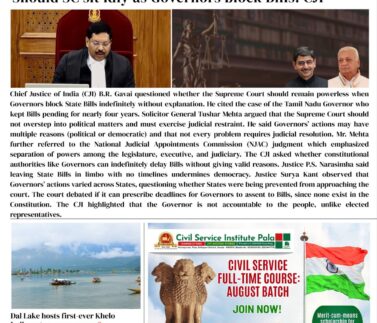
Daily News – 24-08-2025
Russia requires a UN pledge, Ukrainian neutrality: Lavrov
- Russia wants a group of United Nations Security Council (UNSC) members to act as guarantors of Ukraine’s security. This proposal includes permanent UNSC members: Britain, China, France, Russia, and the United States, along with other countries. The concept was previously discussed by Presidents Vladimir Putin and Donald Trump, and featured in 2022’s failed Istanbul negotiations.
- Russia and Ukraine had considered Ukraine’s permanent neutrality in exchange for security guarantees. The requested guarantee would be for Ukraine to remain neutral, non-aligned with military blocs, and non-nuclear. Russia rejects NATO membership for Ukraine, deeming it unacceptable. Russia desires protection for Russian speakers in Ukraine and insists territorial discussions are needed. U.S. Vice-President J.D. Vance dismisses Russia’s demand, stating Moscow is unwilling to settle peacefully.
Trout farming in trouble in Himachal as flash floods take toll on fisheries sector
Trout farming in Himachal Pradesh faces major challenges as frequent flash floods and heavy rains damage the region’s fragile aquatic habitats, severely impacting fisheries and the livelihood of many families.
Impact of Flash Floods on Trout Farming
- The rise in flash flood incidents, especially in high- altitude rivers like the Beas, Sutlej, and Ravi, is harming habitats vital for brown and rainbow trout.
- Muddy water and debris from floods lead to high mortality in trout, a species that requires clean, oxygen-rich water.
- Fisheries across districts such as Kullu and Mandi have suffered significant economic losses, with many farmers affected.
Response and Appeals
- The Fisheries Department has urged the state government to include trout farmers in the disaster relief manual, highlighting that current relief provisions do not cover them.
- Approximately 742 families in the state are involved in trout production and rely on fisheries for their livelihood.
Broader Concerns
- Experts note that flash floods also raise broader ecological concerns by endangering aquaculture and impacting the Himalayan ecosystem.
- Despite Himachal Pradesh’s efforts to promote aquaculture and youth involvement in fishery enterprises, frequent natural disasters pose ongoing risks.
- Government figures indicate there have been more than 75 flash flood incidents in Himachal Pradesh this year alone, underlining the urgency of the issue.
- Brown Trout (Salmo trutta fario) and Rainbow Trout (Oncorhynchus mykiss) are the primary species cultivated in the Himalayas.
- These fish require cold water, flourishing in temperatures between 5°C and 15°C.
- Trout is a sought-after “low volume, high value” fish, making its farming potentially profitable for both domestic consumption and export.
T.N. school introduces uniforms with QR code to enhance students’ safety
A school in Tamil Nadu’s Tiruchi has introduced uniforms with QR codes to enhance student safety, marking a first among local Corporation schools.
- Corporation Elementary School in Edamalaipatti Pudur now equips uniforms for Classes I to V with QR codes containing essential student information like class, name, and address.
- Different shirt colors distinguish each class, and scanning the QR code helps quickly identify students, especially in emergencies or if a child is lost.
- The school plans to expand the QR code data to include more details such as roll number, house address, and parents’ contact information.
- The introduction of QR code uniforms and other initiatives has led to rising enrolment, with 650 students and 18 teachers, and expectations of over 200 new admissions next year.
Benefits:
- Enhanced Safety: The system provides a rapid method for identifying a lost child and facilitating their safe return.
- Reduced Anxiety: For parents and school administrators, it offers a layer of reassurance knowing that help can be obtained quickly in an emergency.
- Easy Identification: It simplifies the process of connecting a lost child to their family.
- This initiative is a proactive step by the school to leverage technology for the well-being and security of its students.
India, China plan to resume trade via Shipki-La in Himachal
India and China have agreed in principle to resume trade through the Shipki-La pass in Himachal Pradesh, which had been suspended since 2020 due to the COVID-19 pandemic.
- China agreed to India’s proposal to restart trade via Shipki-La in Kinnaur district, following discussions during Chinese Foreign Minister Wang Yi’s visit to India.
- The External Affairs Minister, S. Jaishankar, informed the Himachal Pradesh State government that the Union government has initiated talks with China for reopening three trade routes: Shipki-La (Himachal Pradesh), Lipulekh (Uttarakhand), and Nathu La (Sikkim).
- Himachal Pradesh’s consistent efforts to resume trade at Shipki-La received positive results, especially after intervention by Chief Minister Sukhvinder Singh Sukhu, who appealed to the Union government.
- The Union government formally discussed the matter with China and reached a consensus to reopen the route.
- The State government will now engage with the Union Commerce Ministry for trade formalities.
- There is also progress on resuming the Kailash Mansarovar Yatra through Shipki-La, after the route via Lipulekh and Nathu La was reopened following a five-year gap.
- Discussions are ongoing about adding Shipki-La as an official route for the pilgrimage.
DRDO successfully conducts maiden tests of indigenous integrated air defence system
- The Defence Research and Development Organisation (DRDO) successfully conducted maiden flight tests of the Integrated Air Defence Weapon System (IADWS) off the coast of Odisha on Saturday at 12:30 p.m.
- IADWS is a multi-layered air defence system comprising Quick Reaction Surface-to-Air Missiles (QRSAM), Advanced Very Short Range Air Defence System (VSHORADS) missiles, and a high-power laser-based Directed Energy Weapon (DEW), with centralized command and control developed by DRDO.
- Three different targets (including UAVs and drones) were simultaneously engaged and destroyed during the test by QRSAM, VSHORADS, and the DEW, demonstrating the system’s full spectrum of integrated capabilities.
- The tests were witnessed by senior DRDO scientists and armed forces representatives.
- Defence Minister Rajnath Singh complimented DRDO and the armed forces, stating that the test establishes India’s multi-layered air-defence capability and strengthens the defence of important facilities against aerial threats.
- All test operations, including missile launches, drone detection, weapon command and control, communications, and radars, performed flawlessly as confirmed by range instruments.
- Secretary of Defence R&D and DRDO Chairman Dr. Samir V. Kamat congratulated all teams involved in the successful flight tests.
- This marks another step towards developing a homegrown nationwide security shield from multidomain enemy attacks under Mission Sudarshan Chakra by 2035.
- The shield is expected to offer multiple layers of protection by combining surveillance, cybersecurity, and air defence systems to detect and destroy threats, including long-range missiles, aircraft and unmanned aerial vehicles, along the borders and at critical installations.
ISRO holds air-drop test for Gaganyaan mission
Event:
- ISRO conducted its first Integrated Air Drop Test (IADT-1) for the Gaganyaan mission in Bengaluru.
- A dummy crew capsule (~5 tonnes) was air- dropped from an Indian Air Force helicopter.
Objective:
- To test the parachute-based deceleration system designed for safe re-entry and landing of the crew capsule.
- Ensure capsule slows down reliably in real-world conditions after atmospheric re-entry.
Test Process:
- Capsule lifted by helicopter → released from height → parachutes deployed sequentially.
- Checked descent, post-splashdown, and recovery phases.
- Main parachutes opened at specific sequences to control descent and splashdown.
Significance:
- Critical milestone in preparing for India’s first human spaceflight mission (Gaganyaan).
- Parachute deployment is one of the most risky stages for astronauts.
Collaboration:
- Test involved multiple national agencies including the Air Force, Defence Research and Development Organisation (DRDO), Navy, and Coast Guard.
Government Update:
- Union Minister Jitendra Singh informed Parliament that:
- Major preparatory work for Gaganyaan is complete.
- Crew escape systems, motor tests, and environmental control systems developed.
- Infrastructure in place for crew training, vehicle integration, and mission control.
- Precursor test vehicle flights are underway.
130th Constitution Amendment Bill banks on power of arrest, runs the risk of politicising it
Purpose of the Bill:
- Aims to prevent Prime Ministers, Chief Ministers, and Ministers from running governments while in jail.
- Response to political corruption.
Core Provision:
- Relies on the power of arrest to disqualify constitutional authorities (like PM/CM).
- If a person is arrested and detained for 48 hours or more, and remains in custody for 30 days, they automatically lose office.
Criticism:
- Opposition calls it “unconstitutional.”
- Risks of politicisation and misuse of arrest powers against opponents.
- Bill does not specify who can arrest or the exact laws under which such arrests apply.
Judicial Concerns:
- Supreme Court has warned against misuse of arrests for political harassment.
- Courts have stressed that “power to arrest” ≠ “need to arrest.”
Key rulings:
- Joginder Kumar vs State of UP: Arrest must be justified, not just lawful.
- Arnesh Kumar judgment: Discouraged unnecessary arrests.
Recent Context:
- Example: Delhi CM Arvind Kejriwal’s bail in CBI case highlighted issues of political arrests.
- Supreme Court criticized excessive incarcerations under money laundering laws.
Risks Identified:
- Bill could incentivize politically motivated arrests.
- May undermine democratic functioning by targeting elected leaders.
- Balancing act needed between law enforcement and preventing harassment.
Is India underestimating the cost of dealing with invasive species?
Global Findings:
- A new study in Nature Ecology & Evolution estimated global damage from invasive species at $2.1 trillion since 1960.
- Costs may have been underestimated by 16 times compared to earlier estimates.
Most economically impactful groups:
- Plants ($896 billion)
- Arthropods ($580 billion)
- Mammals ($263 billion)
India-Specific Insights:
- India has not fully assessed the economic costs of invasive species.
- Management expenditure likely underreported, leading to hidden costs.
- India struggles with:
- Poor documentation & reporting. Lack of centralised data.
- Limited coordination among agencies.
- Weak prioritisation in control measures.
Who are the Invaders?
- Invasive alien species spread by trade, travel, and human activity.
- Examples: lantana weed (highly combustible), parthenium, prosopis, African catfish, etc.
- They threaten biodiversity, agriculture, human health, and local livelihoods.
Global Comparison:
- Europe had the highest potential impact in absolute terms ($1.5 trillion).
- Followed by North America ($896 billion), Asia ($582 billion), Africa ($127 billion), Australia ($72 billion).
- Europe also had the highest proportion of management costs (41.5%).
- In contrast, India’s expenditure on management is far lower and poorly documented.
Policy & Regulation:
- International agreements (e.g., Ballast Water Management Convention) aim to control spread via shipping.
- Need for stronger surveillance, rapid response, and eradication programmes.
Concerns:
- Invasive species are a byproduct of trade and movement of living organisms.
- Scientists warn that ignoring management will make the problem worse.
- The challenge lies in measuring costs accurately and building effective management strategies.
The ASI is facing a credibility crisis
Keeladi Excavations (Tamil Nadu):
- Began in 2014, uncovering 7,500 artefacts.
- Evidence pointed to a literate and urbanised settlement bridging the gap between the Iron Age (12th–6th century BCE) and the Early Historic Period (6th century BCE).
- Seen as crucial in understanding the Vaigai Valley Civilisation. Political tensions rose after lead archaeologist Dr. Amarnath
- Ramakrishna was transferred in 2017, sparking disputes between the Union and Tamil Nadu governments.
Controversy and Credibility Issues:
- ASI accused of downplaying findings and halting excavations.
- Madras High Court intervened, transferring the site to Tamil Nadu’s State Department of Archaeology, which unearthed 18,000 more artefacts.
- Allegations of political interference, bureaucratic entanglement, and erosion of institutional autonomy.
Other Excavations Highlight Issues:
- Adichanallur (Tamil Nadu): Artefacts over 3,000 years old found, but ASI delayed publishing findings for 15 years.
- Rajasthan (Baihaja site): 23m-deep excavation linked to Rig Veda’s Saraswati River. Unlike Keeladi, findings were quickly associated with Vedic culture, showing inconsistency in approach.
Core Problems Identified:
- Inconsistent approach: Some findings are delayed, others quickly tied to cultural narratives without broader validation.
- Lack of autonomy: Archaeology increasingly driven by nationalist fervour, political agendas, and selective historical interpretations.
- Methodological rigidity & secrecy: Research often withheld, circulated only internally, unlike global best practices (e.g., Germany, France, Japan).
- Weak infrastructure: Poor staff conditions, inadequate funding, slow promotions, lack of comprehensive scientific frameworks.
Consequences:
- ASI’s credibility weakened due to selective publication and ideological bias.
- Growing calls for reforms, greater academic independence, transparency, and international collaboration.
- Without change, ASI risks being seen as serving political narratives rather than scientific truth.
PRELIMS CORNER :
1. The Rafale fighter jets, recently inducted into the Indian Air Force, are manufactured by which country?
(a) Russia
(b) France
(c) Israel
(d) USA
2. Which of the following is the only global convention specializing in the conservation of migratory species, their habitats and migration routes?
(a) Ramsar Convention
(b) Stockholm Convention
(c) Bonn Convention
(d) Washington Convention
3. Among the different types of influenza viruses, which of the following is not known to infect or cause illness in human beings?
(a) Influenza A virus
(b) Influenza B virus
(c) Influenza C virus
(d) Influenza D virus
4. Resolution on Fundamental Rights and National Economic Programme was passed in which of the following Session of Indian National Congress?
(a) Karachi Session, 1931
(b) Haripura Session, 1938
(c) Belgaum Session, 1924
(d) Lahore Session, 1929
Rights groups sound alarm over U.K.’s roll-out of real-time facial recognition
Rollout of Technology:
- UK police are expanding use of real-time facial recognition (FRT), scanning people in large crowds (e.g., Notting Hill Carnival with 2M visitors).
- Technology compares live images with a police watchlist database.
Police Justification:
- Claimed as an “effective policing tool,” already led to 1,000 arrests since 2016.
- Over 4.7 million faces scanned in 2024 alone.
- Used at events like rugby matches, concerts, and coronation of King Charles III.
Criticism & Concerns:
- Rights groups warn of privacy erosion and creation of a “nation of suspects.”
- No legislative basis for its use, leaving police to set their own rules.
- Concerns over racial bias, with Black communities more likely to be unfairly targeted.
- Example: A 39-year-old Black man wrongfully flagged and arrested at a London event, now pursuing legal action.
Retail & Commercial Use:
- Supermarkets and clothing stores also adopting facial recognition to combat shoplifting, sparking further concern about data use and lack of safeguards.
Broader Implications:
- Critics highlight dangers to human rights, anonymity, and freedom of protest.
- Compared to invasive surveillance in China. Academics argue it may discourage public participation in political and cultural life.
Government & Law:
- UK has no specific law regulating FRT use.
- Interior Ministry insists deployment will be limited to “serious crimes.”
- FRT banned in the EU (since Feb 2024) under AI governance law, except for certain uses.
Pakistan Foreign Minister asks Bangladesh to move past the ‘unresolved issues’ of 1971
- Pakistan’s Foreign Minister Mohammad Ishaq Dar visited Dhaka, the first Pakistani FM visit in over a decade.
- He met Bangladesh’s Foreign Minister’s adviser on Foreign Affairs, Touhid Hossain, and other leaders.
Call to Move Past 1971 Issues:
- Pakistan urged Bangladesh to “move ahead” by leaving behind the “unresolved issue” of 1971 atrocities.
- Dar referenced the 1974 Tripartite Agreement between India, Pakistan, and Bangladesh that addressed accountability concerns.
- Emphasised that Bangladesh should “clean its heart” and normalise ties.
Bangladesh’s Response:
- Dhaka highlighted the need for accountability, reparation, and remorse from Pakistan for 1971 atrocities.
- Stressed that Pakistan must acknowledge its actions to improve relations.
China Factor:
- Bangladesh noted that China supports improved Pakistan-Bangladesh ties, and wants balanced relations similar to those with other countries.
Both sides signed MoUs to:
- Set up a Joint Working Group on Trade.
- Enhance cooperation between think tanks and academies.
- Expand collaboration between news agencies (BSS and APP).
- MoU between BIISS (Bangladesh Institute of International and Strategic Studies) and ISSI (Pakistan Institute of Strategic Studies) to strengthen bilateral cooperation in trade, economics, diplomacy, and media.
Education & People-to-People Ties:
- Pakistan launched Pakistan-Bangladesh Knowledge Corridor to offer 500 scholarships to Bangladeshi students over five years.
- Training for 100 Bangladeshi civil servants also announced.
Explained: How have deception techniques evolved?
Evolution of Deception in Warfare:
- Deception has evolved alongside modern weaponry (fighter jets, tanks, warships). Traditional battlefield trickery now merged with digital-age innovations.
- Decoys and countermeasures are used to confuse, mislead, or overwhelm enemy sensors and targeting systems, saving real platforms from attacks.
India’s Deployment:
- During Operation Sindoor, the Indian Air Force (IAF) reportedly used AI-enabled X-Guard Fibre-Optic Towed Decoy (FOTD) developed by Israel’s Rafael.
- Used on Rafale fighters, these systems misdirected enemy missiles, making Pakistan Air Force pilots fire at decoys instead of real jets.
- Analysts suggest Chinese-origin J-10C fighters may also have faced issues against Rafale’s electronic warfare systems.
How the FOTD Works:
- Lightweight, retractable system that mimics the Rafale’s radar and spectral signature.
- Can replicate multiple radar bands, confusing both human operators and automated systems.
- Creates a convincing illusion, preventing enemy missiles from hitting the real aircraft.
- Integrated with Rafale’s SPECTRA electronic warfare suite, enhancing survivability.
Comparable Systems:
- Similar decoys include Leonardo’s BriteCloud, AN/ALE-50 series from Raytheon/BAE, and decoys adapted for Eurofighter Typhoons, Gripens, and F-16s.
- Can also be used on drones (e.g., Israeli Herons, U.S. MQ-9 Reapers).
Land-Based & Ground Forces:
- Ground forces use inflatable decoys (tanks, artillery, missile batteries) since the Gulf War.
- Ukraine has used wooden and 3D-printed decoys to mislead Russian missiles.
- Russia’s Inflatech decoys can simulate armoured formations within minutes.
- U.S. and China also use decoy and camouflage technologies extensively.
Naval Countermeasures:
- Navies deploy floating chaff, acoustic decoys, and towed systems to protect warships.
- Advanced examples: U.S.-developed Nulka missile decoy which draws incoming missiles away from real targets.
- Decoys mimic radar, thermal, and acoustic signatures of ships.
Strategic Importance:
- Deception systems have become indispensable in modern warfare.
- Offer high-impact protection at relatively low cost.
- Seen as critical to enhancing survivability in air, land, and sea combat.
Prelims Corner: Explanations
Q1. Ans b
Rafale is a 4.5-generation multirole fighter aircraft developed by Dassault Aviation of France. India signed an inter- governmental agreement with France in 2016 to acquire 36 Rafale jets, aimed at boosting the Indian Air Force’s combat capabilities. The jets are equipped with Meteor air-to-air missiles and Scalp cruise missiles, enhancing India’s strategic reach.
Q2. Ans c
The Convention on Migratory Species (CMS), also known as the Bonn Convention, is an environmental treaty of the United Nations that provides a global platform for the conservation and sustainable use of terrestrial, aquatic and avian migratory animals and their habitats. CMS brings together the States through which migratory animals pass, the Range States, and lays the legal foundation for internationally coordinated conservation measures throughout a migratory range. As the only global convention specializing in the conservation of migratory species, their habitats and migration routes, CMS complements and co-operates with a number of other international organizations, NGOs and partners in the media as well as in the corporate sector.
Q3. Ans d
There are four types of influenza viruses: types A, B, C and D: Influenza A viruses infect humans and many different animals. The emergence of a new and very different influenza A virus with the ability to infect people and have sustained human-to-human transmission can cause an influenza pandemic. Influenza B viruses circulate among humans and cause seasonal epidemics. Recent data showed that seals also can be infected. Influenza C viruses can infect both humans and pigs, but infections are generally mild and are rarely reported. Influenza D viruses primarily affect cattle and are not known to infect or cause illness in people.
Q4. Ans a
In March 1931, a special session of the Congress was held in Karachi to endorse the Gandhi-Irwin Pact. The Indian National Congress passed the Karachi Resolution at its Karachi session in 1931. Sardar Vallabhbhai Patel was the president of the session. The resolutions on Fundamental Rights and National Economic Policy were passed in that session.
Case Study:
Kerala tourism’s meme-led- makeover to woo Gen next. When the new Squid Game series released, Kerala Tourism dropped a pink soldier into the serene chaos of Munnar’s misty hills. To ride the wave of Superman’s latest release, the handle posted the superhero taking a break in the tranquil backwaters of Kerala. As an April Fools’ Day twist, Kerala Tourism claimed that the Black Panther statue from Wakanda Forever was in spired by Simhapara at Kolukkumalai.
The entire series was a case study in perfect moment marketing riding on global entertainment trends. It had the Internet in whoops, and got global media coverage. Perhaps the first lighthearted take was with the ‘Change of Air’ campaign that Kerala tourism did, which was initially a take on COVID but later also on the Delhi air pollution issue. The overall reach of the meme makeover series was 1.2 million while engagement was 89.7k. Kerala Tourism won the Gold Award for ‘Most Engaging Social Media Campaign’ at the Pacific Asia Travel Association (PATA) meet for its meme-led makeover series.
THE PALA CIVIL TIMES25-08-2025



